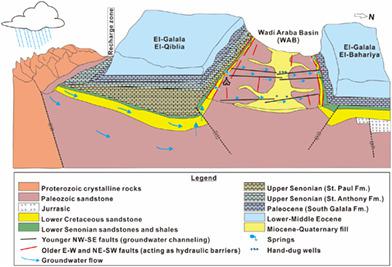当前位置:
X-MOL 学术
›
Hydrol. Process.
›
论文详情
Our official English website, www.x-mol.net, welcomes your
feedback! (Note: you will need to create a separate account there.)
Fault zone hydrogeology in arid environments: The origin of cold springs in the Wadi Araba Basin, Egypt
Hydrological Processes ( IF 2.8 ) Pub Date : 2021-04-15 , DOI: 10.1002/hyp.14176 Mahmoud M. Khalil 1, 2 , Kay Hamer 2 , Thomas Pichler 2 , Abotalib Z. Abotalib 3, 4
Hydrological Processes ( IF 2.8 ) Pub Date : 2021-04-15 , DOI: 10.1002/hyp.14176 Mahmoud M. Khalil 1, 2 , Kay Hamer 2 , Thomas Pichler 2 , Abotalib Z. Abotalib 3, 4
Affiliation

|
The role of faults in controlling groundwater flow in the Sahara and most of the hyper‐arid deserts is poorly understood due to scarcity of hydrological data. The Wadi Araba Basin (WAB), in the Eastern Sahara, is highly affected by folds and faults associated with Senonian tectonics and Paleogene rifting. Using the WAB as a test site, satellite imagery, aeromagnetic maps, field observations, isotopic and geochemical data were examined to unravel the structural control on groundwater flow dynamics in the Sahara. Analysis of satellite imagery indicated that springs occur along structurally controlled scarps. Isotopic data suggested that cold springs in the WAB showed a striking similarity with the Sinai Nubian aquifer system (NAS) water and the thermal springs along the Gulf of Suez (e.g., δ18O = −8.01‰ to −5.24‰ and δD = −53.09‰ to −31.12‰) demonstrating similar recharge sources. The findings advocated that cold springs in the WAB represent a natural discharge from a previously undefined aquifer in the Eastern Desert of Egypt rather than infiltrated precipitation over the plateaus surrounding the WAB or through hydrologic windows from deep crystalline basement flow. A complex role of the geological structures was inferred including: (1) channelling of the groundwater flow along low‐angle faults, (2) compartmentalization of the groundwater flow upslope from high‐angle faults, and (3) reduction of the depth to the main aquifer in a breached anticline setting, which resulted in cold spring discharge temperatures (13–22°C). Our findings emphasize on the complex role of faults and folds in controlling groundwater flow, which should be taken into consideration in future examination of aquifer response to climate variability in the Sahara and similar deserts worldwide.
中文翻译:

干旱环境中的断层带水文地质:埃及瓦迪阿拉巴盆地的冷泉起源
由于缺乏水文数据,人们对断层在控制撒哈拉沙漠和大多数高干旱沙漠中的地下水流量中的作用了解甚少。撒哈拉以东的瓦迪阿拉巴盆地(WAB)受到与塞诺期构造和古近纪裂谷有关的褶皱和断层的强烈影响。使用WAB作为测试地点,对卫星图像,航空磁图,野外观测,同位素和地球化学数据进行了检查,以揭示撒哈拉沙漠地区地下水流动动力学的结构控制。卫星图像分析表明,弹簧沿着结构受控的陡峭峰出现。同位素数据表明,在WAB冷泉表现出惊人的相似与西奈努比亚含水层系统(NAS)和水沿苏伊士湾(例如温泉,δ 18O = −8.01‰至−5.24‰,δD= −53.09‰至−31.12‰),证明了类似的补给源。研究结果认为,WAB的冷泉是埃及东部沙漠先前未定义的含水层的自然排放,而不是WAB周围高原上或通过深部结晶基底流的水文窗口渗入的降水。推断出地质结构的复杂作用,包括:(1)沿低角度断层引导地下水流;(2)高角度断层对地下水流上坡的分隔;(3)减小至深水层的深度。主含水层处于背斜位置,导致冷泉出水温度(13–22°C)。我们的研究结果强调断层和褶皱在控制地下水流中的复杂作用,
更新日期:2021-05-12
中文翻译:

干旱环境中的断层带水文地质:埃及瓦迪阿拉巴盆地的冷泉起源
由于缺乏水文数据,人们对断层在控制撒哈拉沙漠和大多数高干旱沙漠中的地下水流量中的作用了解甚少。撒哈拉以东的瓦迪阿拉巴盆地(WAB)受到与塞诺期构造和古近纪裂谷有关的褶皱和断层的强烈影响。使用WAB作为测试地点,对卫星图像,航空磁图,野外观测,同位素和地球化学数据进行了检查,以揭示撒哈拉沙漠地区地下水流动动力学的结构控制。卫星图像分析表明,弹簧沿着结构受控的陡峭峰出现。同位素数据表明,在WAB冷泉表现出惊人的相似与西奈努比亚含水层系统(NAS)和水沿苏伊士湾(例如温泉,δ 18O = −8.01‰至−5.24‰,δD= −53.09‰至−31.12‰),证明了类似的补给源。研究结果认为,WAB的冷泉是埃及东部沙漠先前未定义的含水层的自然排放,而不是WAB周围高原上或通过深部结晶基底流的水文窗口渗入的降水。推断出地质结构的复杂作用,包括:(1)沿低角度断层引导地下水流;(2)高角度断层对地下水流上坡的分隔;(3)减小至深水层的深度。主含水层处于背斜位置,导致冷泉出水温度(13–22°C)。我们的研究结果强调断层和褶皱在控制地下水流中的复杂作用,











































 京公网安备 11010802027423号
京公网安备 11010802027423号